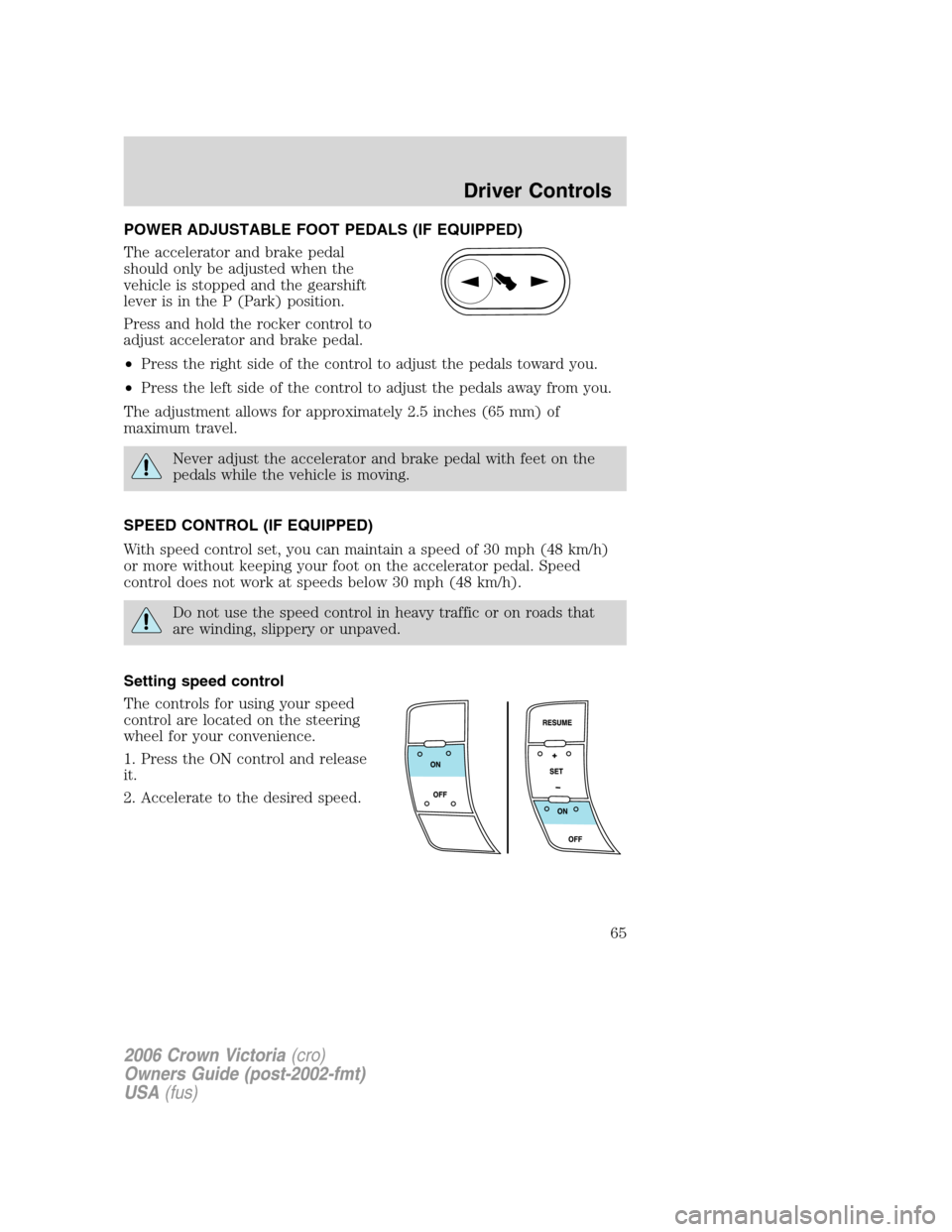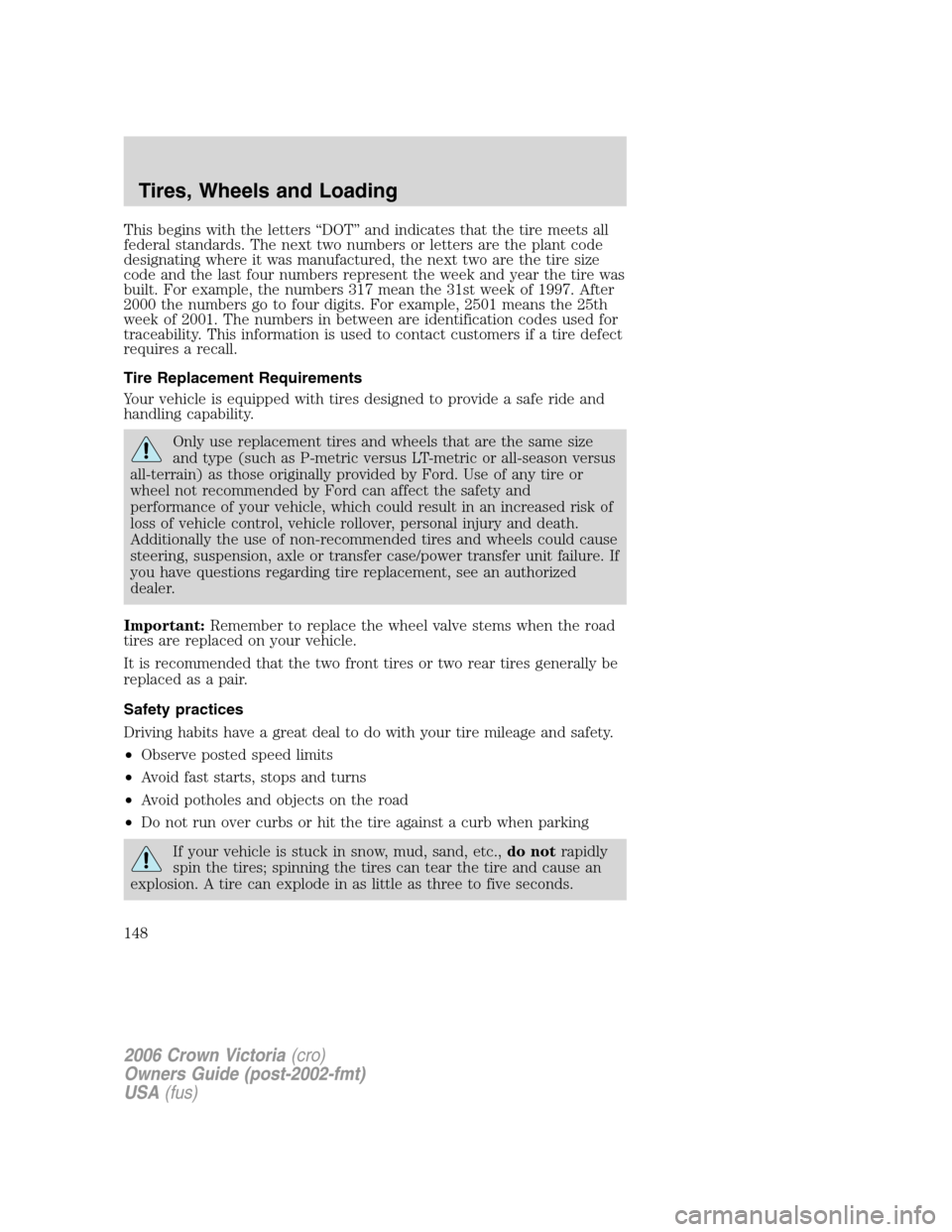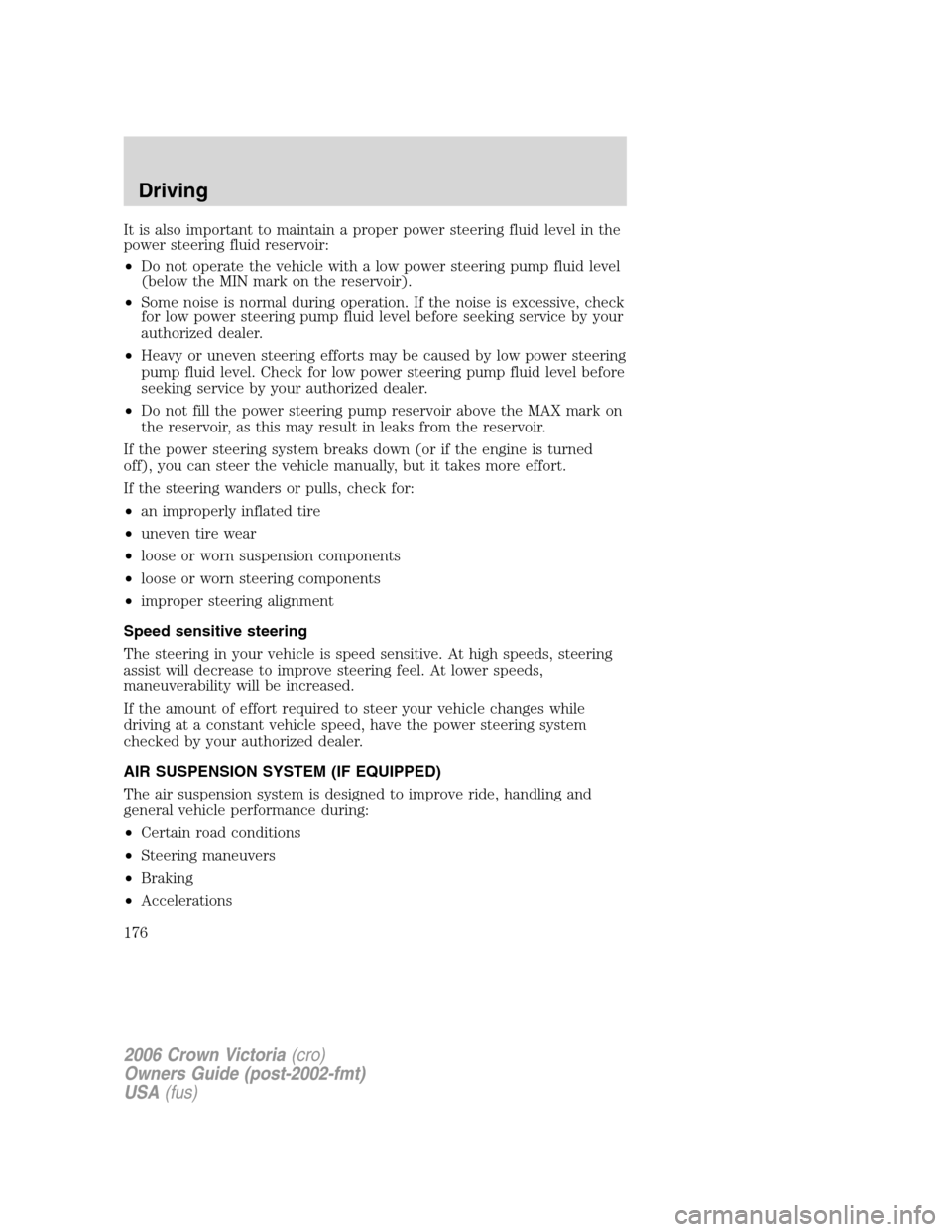Page 1 of 272
Introduction 4
Instrument Cluster 10
Warning lights and chimes 10
Gauges 14
Entertainment Systems 17
AM/FM stereo 17
AM/FM stereo cassette 19
AM/FM stereo with CD 21
AM/FM stereo cassette with CD 25
AM/FM stereo with cassette and in-dash six CD 30
Climate Controls 36
Manual heating and air conditioning 36
Automatic temperature control 37
Rear window defroster 39
Lights 40
Headlamps 40
Turn signal control 42
Bulb replacement 45
Driver Controls 51
Windshield wiper/washer control 51
Steering wheel adjustment 51
Power windows 62
Mirrors 64
Speed control 65
Moon roof 69
Message center 73
Locks and Security 83
Keys 83
Locks 83
Anti-theft system 90
Table of Contents
1
2006 Crown Victoria(cro)
Owners Guide (post-2002-fmt)
USA(fus)
Page 9 of 272
Vehicle Symbol Glossary
Power Windows
Front/Rear
Power Window Lockout
Child Safety Door
Lock/UnlockInterior Luggage
Compartment Release
Symbol
Panic AlarmEngine Oil
Engine CoolantEngine Coolant
Temperature
Do Not Open When HotBattery
Avoid Smoking, Flames,
or SparksBattery Acid
Explosive GasFan Warning
Power Steering FluidMaintain Correct Fluid
LevelMAX
MIN
Emission SystemEngine Air Filter
Passenger Compartment
Air FilterJack
Check Fuel CapLow Tire Pressure
Warning
2006 Crown Victoria(cro)
Owners Guide (post-2002-fmt)
USA(fus)
Introduction
9
Page 65 of 272

POWER ADJUSTABLE FOOT PEDALS (IF EQUIPPED)
The accelerator and brake pedal
should only be adjusted when the
vehicle is stopped and the gearshift
lever is in the P (Park) position.
Press and hold the rocker control to
adjust accelerator and brake pedal.
•Press the right side of the control to adjust the pedals toward you.
•Press the left side of the control to adjust the pedals away from you.
The adjustment allows for approximately 2.5 inches (65 mm) of
maximum travel.
Never adjust the accelerator and brake pedal with feet on the
pedals while the vehicle is moving.
SPEED CONTROL (IF EQUIPPED)
With speed control set, you can maintain a speed of 30 mph (48 km/h)
or more without keeping your foot on the accelerator pedal. Speed
control does not work at speeds below 30 mph (48 km/h).
Do not use the speed control in heavy traffic or on roads that
are winding, slippery or unpaved.
Setting speed control
The controls for using your speed
control are located on the steering
wheel for your convenience.
1. Press the ON control and release
it.
2. Accelerate to the desired speed.
2006 Crown Victoria(cro)
Owners Guide (post-2002-fmt)
USA(fus)
Driver Controls
65
Page 148 of 272

This begins with the letters “DOT” and indicates that the tire meets all
federal standards. The next two numbers or letters are the plant code
designating where it was manufactured, the next two are the tire size
code and the last four numbers represent the week and year the tire was
built. For example, the numbers 317 mean the 31st week of 1997. After
2000 the numbers go to four digits. For example, 2501 means the 25th
week of 2001. The numbers in between are identification codes used for
traceability. This information is used to contact customers if a tire defect
requires a recall.
Tire Replacement Requirements
Your vehicle is equipped with tires designed to provide a safe ride and
handling capability.
Only use replacement tires and wheels that are the same size
and type (such as P-metric versus LT-metric or all-season versus
all-terrain) as those originally provided by Ford. Use of any tire or
wheel not recommended by Ford can affect the safety and
performance of your vehicle, which could result in an increased risk of
loss of vehicle control, vehicle rollover, personal injury and death.
Additionally the use of non-recommended tires and wheels could cause
steering, suspension, axle or transfer case/power transfer unit failure. If
you have questions regarding tire replacement, see an authorized
dealer.
Important:Remember to replace the wheel valve stems when the road
tires are replaced on your vehicle.
It is recommended that the two front tires or two rear tires generally be
replaced as a pair.
Safety practices
Driving habits have a great deal to do with your tire mileage and safety.
•Observe posted speed limits
•Avoid fast starts, stops and turns
•Avoid potholes and objects on the road
•Do not run over curbs or hit the tire against a curb when parking
If your vehicle is stuck in snow, mud, sand, etc.,do notrapidly
spin the tires; spinning the tires can tear the tire and cause an
explosion. A tire can explode in as little as three to five seconds.
2006 Crown Victoria(cro)
Owners Guide (post-2002-fmt)
USA(fus)
Tires, Wheels and Loading
148
Page 175 of 272

During Traction Control�operation you may hear an electric motor type
of sound coming from the engine compartment and the engine will not
“rev-up” when you push further on the accelerator. This is normal
system behavior.
If you should become stuck in snow
or ice or on a very slippery road
surface, try switching the Traction
Control�system off. This may allow
excess wheel spin to “dig” the
vehicle out and enable a successful
“rocking” maneuver.
The traction control indicator
flashes during a Traction Control�
system event.
If the traction control indicator
comes on and stays lit, either:
•the Traction Control�system
requires service by an authorized dealer, or
•the customer has disabled the system using the traction control switch
located on the left side of the instrument panel.
The Traction Control�system will be on every time you turn the ignition
key from OFF to ON until you deactivate the system using the traction
control switch on the instrument panel left of the steering column.
STEERING
Ford Motor Company recommends that an authorized dealer
inspect all steering column assemblies in use in vehicles involved
in a collision. Failure to inspect and if necessary replace the steering
column assembly could result in severe injury or death in the event of
a collision.
Do not attempt to service, repair, or modify the steering column,
its adaptive module, or its fuses. See your authorized dealer.
To prevent damage to the power steering system, never hold the steering
wheel at its furthest turning points (until it stops) for more than a few
seconds when the engine is running.
2006 Crown Victoria(cro)
Owners Guide (post-2002-fmt)
USA(fus)
Driving
175
Page 176 of 272

It is also important to maintain a proper power steering fluid level in the
power steering fluid reservoir:
•Do not operate the vehicle with a low power steering pump fluid level
(below the MIN mark on the reservoir).
•Some noise is normal during operation. If the noise is excessive, check
for low power steering pump fluid level before seeking service by your
authorized dealer.
•Heavy or uneven steering efforts may be caused by low power steering
pump fluid level. Check for low power steering pump fluid level before
seeking service by your authorized dealer.
•Do not fill the power steering pump reservoir above the MAX mark on
the reservoir, as this may result in leaks from the reservoir.
If the power steering system breaks down (or if the engine is turned
off), you can steer the vehicle manually, but it takes more effort.
If the steering wanders or pulls, check for:
•an improperly inflated tire
•uneven tire wear
•loose or worn suspension components
•loose or worn steering components
•improper steering alignment
Speed sensitive steering
The steering in your vehicle is speed sensitive. At high speeds, steering
assist will decrease to improve steering feel. At lower speeds,
maneuverability will be increased.
If the amount of effort required to steer your vehicle changes while
driving at a constant vehicle speed, have the power steering system
checked by your authorized dealer.
AIR SUSPENSION SYSTEM (IF EQUIPPED)
The air suspension system is designed to improve ride, handling and
general vehicle performance during:
•Certain road conditions
•Steering maneuvers
•Braking
•Accelerations
2006 Crown Victoria(cro)
Owners Guide (post-2002-fmt)
USA(fus)
Driving
176
Page 188 of 272

Fuse/Relay
LocationFuse Amp
RatingPassenger Compartment Fuse
Panel Description
1 15A Taxi roof lamp, Cluster, Lighting
Control Module (Interior Lighting)
2 10A Ignition (ON) - Electronic
Automatic Temperature Control
(EATC) module, A/C mode switch
(vehicles equipped with manual
A/C only), A/C blower relay coil
3 10A EATC module (vehicles equipped
with EATC only)
4 10A Ignition (ON) - Anti-lock Brake
System (ABS) module, Rear Air
Suspension Module (RASM),
Variable Assist Power Steering
(VAPS)
5 10A Speed control deactivation switch,
Stop signal
6 10A Ignition (ON) - Cluster
7 15A LCM (Park lamps, Corner lamps)
8 10A LCM
9 10A LCM (Switch illumination)
10 5A Ignition (START) - Audio mute,
Police PDB (Police vehicles only)
11 10A Ignition (ON/ACC) - (window)
relay coil (non-Police vehicles
only)
Ignition (ON/ACC) - (window and
decklid) relay coil and Police
ON/ACC relay coil (Police vehicles
only)
12 10A Ignition (START) - Starter relay
coil, DTRS
13 10A Ignition (ON/ACC) - Wiper
module
14 10A Ignition (ON) - BTSI (Floor-shift
transmission)
2006 Crown Victoria(cro)
Owners Guide (post-2002-fmt)
USA(fus)
Roadside Emergencies
188
Page 223 of 272
IDENTIFYING COMPONENTS IN THE ENGINE COMPARTMENT
4.6L SOHC V8 engine
1. Brake fluid reservoir
2. Engine oil dipstick
3. Windshield washer fluid reservoir
4. Air filter assembly
5. Power steering fluid reservoir
6. Engine coolant reservoir
7. Battery
8. Power distribution box
9. Engine oil filler cap
10. Automatic transmission fluid dipstick
2006 Crown Victoria(cro)
Owners Guide (post-2002-fmt)
USA(fus)
Maintenance and Specifications
223